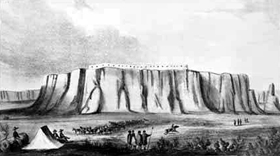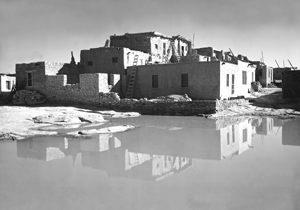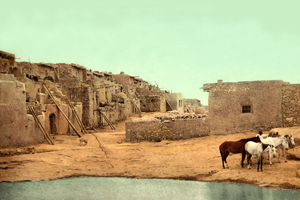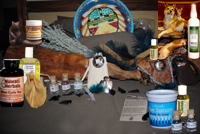New Mexico Legends Acoma Pueblo - Ancient Sky City

NEW MEXICO LEGENDS Acoma Pueblo - Ancient Sky City
Strategically built atop a 357-foot sandstone mesa for defensive purposes, the Acoma Pueblo is more familiarly known as Sky City. Believed to be the oldest continuously inhabited city in the United States, the pueblo was built sometime between 1100 and 1250 A.D.
The name "Acoma" means "People of the White Rock" in the Puebloan Kersan dialect. The pueblo , covering some 70 acres, is actually comprised of several villages including Acomita, McCartys, Anzac and Sky Line.
The site was chosen, in part, because it provided a defensive position for the tribe against raiders. Access to the pueblo was difficult as the faces of the mesa are sheer and before modern times, it could only be accessed by a hand-cut staircase carved into the sandstone.
For centuries the Acoma people have farmed the valley below the Acoma Pueblo using irrigation canals in the villages closer to the Rio San Jose River. They were also actively involved in trading, not only with neighboring pueblos, but, also over long distances with the Aztec and Mayan peoples.
Acoma Pueblo, photograph by Ansel Adams, about 1942.
Image available for photo prints & editorial downloads HERE .
 The pueblo was already well established when Francisco Vasquez de Coronado was the first European to lay eyes on it in 1540, describing it as: "One of the strongest ever seen, because the city was built on a high rock. The ascent was so difficult that we repented climbing to the top."
The pueblo was already well established when Francisco Vasquez de Coronado was the first European to lay eyes on it in 1540, describing it as: "One of the strongest ever seen, because the city was built on a high rock. The ascent was so difficult that we repented climbing to the top."
Almost fifty years later, Sky City was almost destroyed in 1598 when Governor Juan de Oñate, under orders from the King of Spain, invaded New Mexico , and began staging raids on Native American pueblos in the area, taking anything of value. When the Spanish soldiers arrived in the area, they made their headquarters at the Ohkay Owingeh Pueblo , formerly called the San Juan Pueblo, located about 25 miles north of Santa Fe . Upon their arrival, they removed the Tewa tribe who lived there and used it as a base to stage more raids on other Native American pueblos in the area.
In December, 1898, a party of Spanish soldiers seeking food arrived at Acoma. Initially, they were welcomed and treated in a friendly manner until the soldiers turned aggressive and began to demand grain from the Acoma storehouses, which was needed for the tribe to survive the winter. Provoking a furious reaction, the Acoma attacked the soldiers, killing 13 of them, including their commander, Juan de Zaldivar, who was a nephew of Juan de Oñate.
In response, Oñate resolved to make an example of Acoma, and dispatched 70 of his best men, under the command of Vicente de Zaldivar, to attack the Acoma Pueblo. On January 21, 1599, the Spanish troops came into view of the pueblo and the tribe fanned out from their village to guard the edge of the mesa. As the Spaniards drew closer, the defenders unleashed a barrage of rocks and arrows down on them. Despite the defensive barrage coming from atop the mesa, the soldiers fought their way to the top over the next three days. During the battle, the Spaniards brought a small cannon up the back of the mesa and began firing into the village. The battle then became a massacre and when it was over, as many as 800 Acoma people were dead and their pueblo in ruins.
Afterwards, the survivors were marched to the Santo Domingo Pueblo (now known as the Kewa Pueblo ), where all males over the age of 12 were condemned to 20 years' servitude. Of the few dozen Acoma men of fighting age who were still alive after the battle, they were sentenced to have one foot cut off. The surviving children under the age of 12 were taken from their parents, and given to Spanish missionaries to raise. However, most of them, as well as the women were sold into slavery. Oñate was later tried, convicted of cruelty to Indians and colonists, and was banished from New Mexico . However, he appealed the ruling and was later cleared of all charges. He lived out the rest of his life in Spain.
In the end, the approximate population of the 2,000 people who had lived at the Acoma Pueblo was reduced to approximately 250 survivors. In time, some of the Acoma people managed to escape and made their way home, where they began the long process of rebuilding. Since that time, it has been continuously inhabited and never again fell to an invader.
Decades later, In 1629, as a "gesture of peace" and to attempt to Christianize the Indians , the Spanish began to build the San Estéban del Rey Mission, which included a church, convent, and cemetery. All of the building materials, including some 20,000 tons of earth and stone, were hand carried or hauled up the steep slopes of the mesa. The mission’s 30-foot beams were carried 30 miles from Mount Taylor and Kaweshtima. Under the guidance of Friar Juan Ramirez the pueblo was finally completed in 1640. However, according to Acoma oral tradition, the people were forced by Ramirez to build the mission.
These abuses of power by both religious and political authorities eventually led to the Pueblo Revolt . On August 10, 1680, some 17,000 thousand Puebloans, including 6,000 warriors rose up in vengeance against 2,500-3,000 colonists. The tribes struck mission churches, killing 22 of 33 friars and demolishing and burning many of them. Warriors attacked isolated farms and haciendas, killing entire families. The Acoma participated in the Revolt by killing the Spanish friars who were living at the mesa at the time, but, did not destroy the church. It was one of the few Spanish missions to survive the revolt intact. The Puebloans were again forced to submit to Diego de Vargas in 1692. The Acoma joined in another uprising in 1696, but, were again subdued in 1699.
Acoma Pueblo about 1900, by the Detroit Publishing Company.
Image available for photo prints & editorial downloads HERE . .
Today, the San Estéban del Rey Mission church houses the largest inventory of early 17th century building material of any structure in New Mexico . It features a large collection of Spanish colonial ecclesiastic art, an original hand-hewn circular staircase, hand-carved rails, and paintings.
Acoma is, along with the Hopi town of Oraibi, the oldest inhabited settlement in the United States. A federally recognized Indian Tribe, the Acoma Pueblo now has a land base covering 431,664 acres and is home to 4,800 tribal members. Both the San Estéban del Rey Mission and the pueblo itself have been proclaimed National Historic Landmarks.
Today's Acoma people continue the traditions of their ancestors who they trace to the former inhabitants of older ruins to the north and west of their present-day pueblo. Some also practice their ancient religion while others converted to Catholicism long ago when the first Spanish settlers arrived in the 1500's. Throughout the years celebrations and feasts are held for religious and historic occasions. While visitors are allowed to attend, they are encouraged to be respectful and aware of local protocol.
Today, fewer than 50 of the 3,000 Acomans live at the pueblo, the remaining residents choosing to live in the nearby villages. The Acoma Pueblo is known for its amazing pottery and a permanent exhibit, One Thousand Years of Clay, is housed in the Visitors Center located at the base of the mesa along with native food and crafts shops.
The tribe also operates the Acoma Route 66 Interpretive Center just off I-40 and the Acoma Commercial Center. In addition, the pueblo also offers fishing for a fee at its newly built Acoma Lake.
The pueblo is located 60 miles west of Albuquerque on Interstate 40 and 12 miles south on Indian Route 23. From Grants , Acoma is just 12 miles east on I-40. The pueblo is open for guided tours between March and October. A fee is required and no cameras are allowed without license. Check with the Sky City visitor center at the base of the mesa.
© Kathy Weiser / Legends of America , updated December, 2015.
Contact Information:
Acoma Pueblo
P.O. Box 309
Acoma Pueblo, New Mexico 87034
888-759-2489 or 505-552-6604
Also See:
Pueblo Revolt - Rising Up Against the Spaniards
Ancient Cities of Native Americans
Ancient Puebloans of the Southwest
Pueblo Indians - Oldest Culture in the U.S.
Pueblo and Reservation Etiquette







The oldest city in American, older than St. Augustine FL.
It has survived in spite of the Spanish.
It is well worth the time to see, although it takes special permission from the Acoma to access it.
19 tribes/nations/pueblos are in NM and none of them have ever been defeated in battle by the U. S. The U. S. and the pueblos have never signed treaties and the pueblos have retained their lands since well over 10,000 years ago. After Spain "conquered" them and the U. S. conquered Spain, the U. S. acknowledged that the pueblos had "land grant" status - land returned/given to them by the King/Queen of Spain that had originally been theirs.
Yet, the U. S. "decided" that the pueblo natives were to be made "wards/dependents" of the U. S. after the Treaty of Guadalupe in which the lands of NM/AZ were taken by the U. S. through the Gadsen Purchase and after the pueblos sued the U .S. in 1916 to be recognized as Native Americans.
Because Pueblos were granted full Mexican citizenship while under Mexican rule from 1821 to 1848, they automatically became U.S. citizens when the Southwest was annexed by the United States at the conclusion of the Mexican War in 1848. The Pueblos were the only Indians in the Southwest to become U.S. citizens in that manner. Pueblos had to sue to have their status as Indians recognized by the United States, which was achieved by a decision of the U.S. Supreme Court in 1916. They are now federally recognized Indian tribes. By joining together to form the All Indian Pueblo Council in the 1920s, (but originally formed in 1598) after a congressional investigation had revealed that 12,000 non-Pueblo claimants were living on Pueblo land, they succeeded in getting the U.S. Congress to pass the Pueblo Lands Act of 1924, which secures some of their traditional land to them.
Read more:
The Acoma Pueblo people are amazing and have some of the most beautiful arts/crafts/traditions many have ever seen, including myself.
Really an amazing people and history, 1st.
Wow, 1st! Thanks for sharing!!!
It's very fitting for you to have posted your link in turquoise colour.
Although I've seen a fair amount of the USA, I regret not having seen the Pueblos and their part of the country.
You would have loved them Buzz.
I'd love to see it, but if Francisco Vasquez de Coronado and his men couldn't make it all of the way up, how do older tourist such as myself get up there? I'm good for about two or maybe three stories of steps and then that's it. My legs can't take anymore then that. And my wife is handicapped (her left ankle bones are held together with pins and screws and she walks very slowly) so is it handicap accessible?
Randy, I don't remember if it is handicapped accessible or not.
I do have a solution though. NM is the hub for hot air ballooning, you see where I'm going with this, right?
I have always wanted to go on one! My wife refuses, but my mother and step-father renewed their wedding vows and had a dinner on one for their 20th anniversary. It's a good thing they did it when they did, because he developed breast cancer the following year and died within 6 weeks of finding out.
Maybe I'll go alone and let her wait!
Randy over the Acoma Pubelo, ready to make a landing...
If they wanted a lot of tourism up top they could do what other difficult to climb hilltop places, like Masada, have done, and construct a cable car access.
I don't think that they would ever do that Buzz, since it still is a lived in city. Besides it wouldn't be proper in a spiritual sense.
Just my opinion on it.
Agree - too many traditions, heritage and culture that would get ruined by a great influx of "outsiders". This is their home - and they want it to stay theirs.
If they wanted a lot of tourism up top they could do what other difficult to climb hilltop places, like Masada, have done, and construct a cable car access.
I could be wrong but I didn't get the impression that they want a high traffic tourist site. Purely a vibe but I felt like they like the natural limit on the number of white people visiting the reservation at one time.
Amazing to see this place stand the test of time and the test of those Spanish who tried to destroy it and the Puebloans way of life. I would love to go there one day and see it. My cousins have and they said it was amazing.
Thanks for the really interesting article. I don't think that many people know about this.
Perrie, there a many fascinating sites in NM...Well worth the trip and spending some time there.
One of the sad things Perrie is that the folks in NM (government wize) love to use Onate's name on just about everything - even after he massacred as many of the Pueblo folks that he could. He was tried and convicted by the King and Queen of Spain and all of his holdings were confiscated.
Funny how history just doesn't get over the first bump, eh?
I've been there and it's as amazing as they say. Isn't the road to the Acoma fortress the one with all these natural giant stone obelisks along the way. I did a lot of traveling in New Mexico to reservations so maybe I mixed it up with something else. I do remember a sign that said I can't take pictures of anything without permission (but I can buy their pictures). My recollection is that they're on the reservation itself but a distance from the fortress. They look like they would all fall over like dominoes if one crashed into the other. I don't think I've ever seen them mentioned anywhere but they're amazing too.
I don't remember 1ofmany, it was decades ago that I was there.
I don't remember 1ofmany, it was decades ago that I was there.
These guys from the Laguna reservation invited me over and suggested that I stop to see Acoma. There are so many reservations, that I only remember bits and pieces so I might be mixing and matching. I loved New Mexico and felt quite at home there everywhere I went.
I've heard of the Pueblo all my life, and how wonderful this place is! I've always wanted to go, but will need to go by donkey now... Maybe someday! I hope...
Donkey! Now there is an idea! They could (if the path or steps are wide enough) offer donkey rides up to the top!
Besides, what fun! Just give me enough pain killers and I could manage it... And a left stirrup that turns outward, not inward. Yeah, I could do that...
I'd need a Valium first myself.
Probably wouldn't hurt...
And maybe a double tequila...
It is well worth the trip Dowser. Along with Acoma Pueblo there are amazing Native sites to see.
Not this year, but maybe soon! I'd surely love to see it!
Great article ! I visited it back when I was moving to California. It was recommended and is was well worth it. I was impressed with the large church there. Some of the homes had sheets of mica for window panes.
It really is a sight to behold, Pat.
I would highly recommend it for a great view into the past and present.
Beautiful pottery art there to.
Some of the finest pottery in the world, Pat.
As Kavika noted, there are a lot of reservations in New Mexico. Some are in very bad condition and the people are poor (in money, not in spirit). There is plenty of jewelry and other items for sale but what I didn't realize at first was how much of it (off the reservation) is from China. I was going into a shop in downtown Albuquerque and an Indian woman standing outside begged me to buy her bead work. I didn't want it but before I could say that, the owner of the store came out to shoo her away. She broke into tears saying that she wasn't hurting anybody and she was just trying to live but it was hard because the foreign merchandise was so cheap. What foreign merchandise I asked? She said all the stuff in there was foreign made. I went in to see for myself and it was mostly true. Maybe she was hustling me but I bought her bead work anyway and, from then on, did business only on the reservations.
You're right One and Albuquerque stores are starting to get hit with the Indian Arts and Crafts Act due to the fake jewelry. Santa Fe, on the other hand, will not sell fake jewelry. Your best purchases can be made in the "downstairs vault" of many of the stores there. The vaults hold jewelry that the Natives used as pawn on the rez/pueblo. When they or a member of the family couldn't redeem it, the shop would sell it to the markets in town, who would, in turn, sell it from the vaults. One of the reasons is that not many folks know of the vaults which gives the Natives/families potential time to come up with the funding to redeem their family heirlooms.
It's not only in NM 1st, 1of....There are the same type stores in MN, ND, SD, WN, OR, CA. etc etc. I was in a store in TX this year. Same old crap made in China and a few other countries and trying to pass it off as authentic Indian.
Good information on the vaults.
It's happening in Scottsdale AZ too or at least it was several years ago. You go to Old Town Scottsdale and look at "Genuine Indian Jewellery" and find out it was made overseas, usually China. Same with pottery. Then when you point it out to the sales people they always say it's in the "Indian style" or "Spirit" art.
Don't get me wrong. There are some very, very good genuine Indian art, crafts and jewelry shops in Scottsdale, but buyer beware.
It's not only in NM 1st, 1of....There are the same type stores in MN, ND, SD, WN, OR, CA. etc etc. I was in a store in TX this year. Same old crap made in China and a few other countries and trying to pass it off as authentic Indian.
The reason I brought this up is so that other visitors aren't fooled. Many Indians have no source of income other than making jewelry or crafts. We should not help drive them further into poverty by buying faux Indian goods from China.
I remember driving for hours and hours to get to the Ute reservation, and discovering that all of the Indian stuff was made by the Cherokee in SC. Needless to say, we could have just driven to Cherokee, SC to purchase it!
It was "authentic", sort of...
You're right One and Albuquerque stores are starting to get hit with the Indian Arts and Crafts Act due to the fake jewelry. Santa Fe, on the other hand, will not sell fake jewelry. Your best purchases can be made in the "downstairs vault" of many of the stores there. The vaults hold jewelry that the Natives used as pawn on the rez/pueblo. When they or a member of the family couldn't redeem it, the shop would sell it to the markets in town, who would, in turn, sell it from the vaults. One of the reasons is that not many folks know of the vaults which gives the Natives/families potential time to come up with the funding to redeem their family heirlooms.
Yeah they referred to it as "old pawn." I bought it but I had better luck going onto some reservations and buying there directly. Maybe I just liked meeting people on the reservations and talking . . . and boy can they talk.
This is a photo of a hand made Ojibwe vest, floral design. This item is of the finest cloths and all hand stitched and beaded. Price around $300 to $350.
Last year when I was in northern MN I saw some in a sporting good store and stopped to check them out. Guess what, advertised as Indian but the tag said it was made in India...Price $100.
Wrong kind of Indian...
Kavika/1st --
This is a bit off-topic but sometimes I have to ask things while they're on my mind. My Sioux shamen friend once told me that he has many medicines that work. I've personally seen him do some things that defy explanation. Anyway, he once told me that some researchers were bugging him to tell them the ingredients of some of his medicines. He said they could have it (although, to my knowledge, he never actually gave it to them) but he said it wouldn't work. I asked why and he said it won't work without prayer. But prayer for him means singing/chanting (and he was really good at it). I've dealt with other shamen but he's the only one who said this to me. When I started to question him, he cut it short by saying that the great spirit explains things when it's time to know them or something like that. It now dawns on me that the properties of some medicine might actually be activated by sound just like some things are activated by heat. Have either of you ever heard a medicine man say that the medicine won't work without prayer and/or singing?
1ofmany, I think that the first thing that has to be addressed is the term ''Shaman''. This is not an Indian word nor is it tied to any native language. If I remember correctly it's origins are in Siberia.
I have rarely heard an Indian use the term. In our tribe it is ''mide'' of the Midewiwin or Grand Medicine Society. The term Medicine Man is a European term, and does not explain what a mide does or is. Power, knowledge, understanding are intertwined to the medicine term. A mide or medicine man has an understanding of both the physical and non physical world.
I am not surprised that your friend did not give them the information. It's not unusual for this to happen. One of the reasons is that scientists/researchers have come to the tribes and asked for this information and once it was given, the scientists/researchers used it for personal gain. This is not acceptable to any of the Indian tribes. Thus few will give out this type of information. Of course there are additional reason, but this is one of the most important ones.
I would say that by your friend saying that it wouldn't work without singing or chanting is true, but you have to understand what that actually means. The mide or medicine man chants and becomes a conduit between himself and the what non Indians call the Creator or Great Spirit. Actually the word Gitchi Manidou translates to the ''Great Mystery''..the dictionary will tell you that it translates to Great Spirit, but the Ojibwe language is much more complex than a simple single word translation.
Anyhow, your friend was correct, but you would have to have grown up in the tribe and fully understand the culture and language to really know what he was saying about this.
The term Shaman or Medicine Man is somewhat misleading in that in the Grand Medicine Society both men and women are mides.
Hope this helps.
Kavika-- Just to clarify, my friend didn't refer to himself as a shaman. That was my term because what he believed seemed to fall under shamanic practices as I understood them from college. In fact, I don't remember him referring to himself as anything. He simply said he had medicine. Western medicine deals with the body. His medicine went to body and spirit as though they are one so I referred to it as shamanic but I didn't say it to him. Sometimes he said great spirit but I think that was for me. In his singing/chanting, he said wakan tanka. Your explanation that medicine men act as a conduit makes sense and explains some things he did . . . and explains some things that happened once the conduit was open that defy explanation (or rather I can't explain it). Thanks for taking the time to explain the basics.